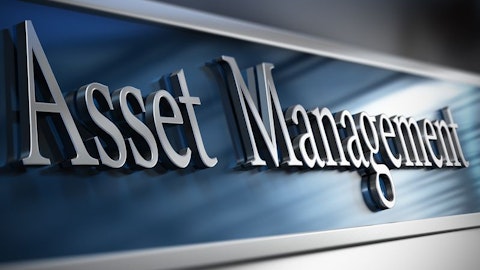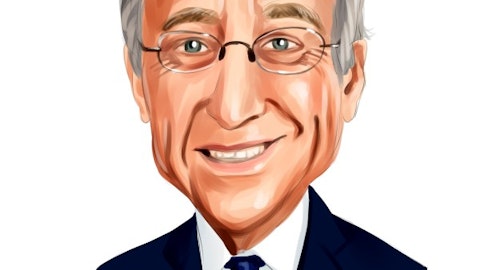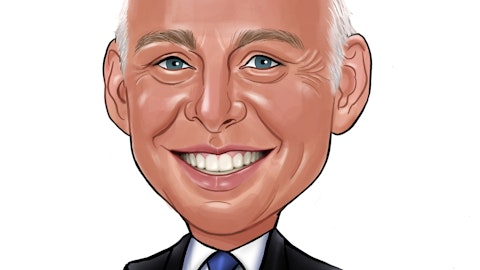Invesco Ltd. (NYSE:IVZ) Q4 2022 Earnings Call Transcript January 24, 2023
Operator: Welcome to Invesco’s Fourth Quarter Earnings Conference Call. All participants will be in a listen-only mode until the question-and-answer session. As a reminder, today’s call is being recorded. Now I would like to turn the call over to Greg Ketron, Invesco’s Head of Investor Relations.
Greg Ketron: Thanks, operator, and to all of you joining us on Invesco’s quarterly earnings call. In addition to today’s press release, we have provided a presentation that covers the topics we plan to address today. The press release and presentation are available on our website, invesco.com. This information can be found by going to the Investor Relations section of the website. Our presentation today will include forward-looking statements and certain non-GAAP financial measures. Please review the disclosures on Slide 2 of the presentation regarding these statements and measures as well as the appendix for the appropriate reconciliations to GAAP. Finally, Invesco is not responsible for and does not edit nor guarantee the accuracy of our earnings teleconference transcripts provided by third parties.
The only authorized webcast are located on our website. Marty Flanagan, President and Chief Executive Officer; and Allison Dukes, Chief Financial Officer, will present our results this morning. After we complete the presentation, we will open the call up for questions. Now I’ll turn the call over to Marty.
Marty Flanagan: Thank you, Greg, and thanks everybody for joining us. And I’m going to start on Slide 3 if you’re following along, which is the fourth quarter highlights. The fourth quarter concluded a year of significant headwinds and volatility in global markets. Seemingly, no geography or asset class was immune to the S&P experienced the worst year since 2008, NASDAQ Composite declined over 30%, MSCI Merchant Markets Index nearly 20%, and bond markets, typically the safe heaven when equity suffer, declined significantly due to rise in interest rates with the global aggregate bond index declining by more than 15% for the year. This resulted in the worst markets we’ve seen in decades. Rising COVID infections in China and tax loss harvesting in developed economies as the year came to a close made for a challenging organic growth dynamic in our industry.
Despite industry challenges in 2022, we’re pleased to see key capabilities in areas with high client demand continued to deliver organic growth, offsetting net outflows and capabilities that experienced redemption pressure as investors express a preference for risk-off assets. Key capabilities that delivered net long-term inflows for the year included ETFs, fixed income, Greater China and the institutional channel. The firm’s ability to deliver these outcomes demonstrates the strength and resilience of our diversified platform in the face of extraordinary market headwinds. Although, market showed signs of stabilization in the fourth quarter, the uncertain backdrop continued to weigh on investor sentiment and impacted client demand. Invesco separated itself from most industry peers by generating net inflows in key capability areas led by strong growth in ETFs in the quarter.
Our fixed income business and institutional channel continued to build on our track record of organic growth, generating net inflows for 16 and 13 consecutive quarters, respectively. The depth and breadth of our investment capabilities that Invesco brings to market that position the firm to return to organic growth when investor sentiment improves. Invesco ETFs delivered $4.3 billion in net long-term inflows during the quarter. For the full year, ETFs brought in $28 billion of net long-term inflows, the equivalent of 11% organic growth rate. Our ETF lineup remains differentiated for most competitive offerings with a focus on higher value, higher revenue market segments like smart beta, and we continue to drive innovation in space with products such as our QQQ Innovation Suite.
Fixed income capabilities in the institutional channel have been pillars of organic growth for several years now and growth persisted in both of these areas in the fourth quarter with $800 million and $900 million of net inflows, respectively. As Allison will discuss later, our institutional pipeline remains at healthy levels. And as interest rates stabilize, we have a significant opportunity to capture growth in fixed income capabilities in 2023. Our business in Greater China performed exceptionally well during 2022, building on our leading position in the world’s fastest-growing market class asset managers. We experienced modest net long-term outflows of $600 million in the fourth quarter due to significantly higher redemptions in fixed income throughout the industry in China and rising bond yields stroke net asset values for fixed income securities lower.
Despite these challenges, we raised over $3 billion from new product launches during the quarter in China. For the full year, our China joint venture delivered $7 billion of net inflows, the equivalent of 11% organic growth rate. Market sentiment in China will be mixed for the next few months as the country works through the transition period of higher COVID infection, stabilizing interest rates and redemptions turned to more moderate levels. That said, there are also signs that the outlook for the remainder of 2023 is improving, and I’m optimistic for a return to organic growth rate throughout 2023 in China. Although, we maintain momentum in key capabilities, the firm experienced net long-term outflows this quarter of $3.2 billion. Active global equity remains the biggest drag on organic growth with $6 billion of net outflows in the fourth quarter, including $3 billion in our developing markets fund.
As we discussed previously, client appetite for these assets have been lower than in the past, but I’m optimistic, redemptions will slow this top client appetite for risk assets will eventually return. We entered 2023 with a strong balance sheet, giving us the needed flexibility to operate strategically in this environment. Long-term debt remains at low levels, the lowest in 10 years, and our cash balance increased to over $1.2 billion at year-end. As we discussed last quarter, we continue to be disciplined in our approach to expenses, tightly managing discretionary spending and limiting higher roles that are critical to support the organization and future growth. We are thoughtfully managing market headwinds while investing for the long-term.
We remain focused on identifying areas of expense improvement that will deliver positive operating leverage as the market recovers and organic growth resumes. We are being extremely thoughtful about capital resource allocation in this environment, and we will be well positioned to maintain investments in areas that deliver future growth. Looking ahead, we are partnering with our clients to meet the most pressing needs in this dynamic environment. We’ve dedicated the past decade to build a breadth of investment capabilities and solutions mindset and operating scale at Invesco that few in the industry can match. I’m proud of our talented what our talent employees have accomplished in 2022 on behalf of clients and stakeholders, and I’m optimistic for return to organic growth when market sentiment eases.
Market direction may be uncertain, but I’m confident that Invesco is prepared to meet challenges that will arise in 2023 and well positioned for future growth. With that, Allison, I’ll turn it over to you.
Allison Dukes: Thank you, Marty, and good morning, everyone. I’m going to start with Slide 4. Overall, investment performance improved in the fourth quarter with 61% and 63% of actively managed funds in the top half of peers or beating benchmark on a three-year and a five-year basis, up from 57% and 62% in the third quarter. These results reflect strength in fixed income and balanced strategies where there is strong client demand. Performance lacks benchmark in certain equity strategies, but we experienced improvement over the past quarter in several key funds and short-term performance is trending positively in several U.S. and global equity strategies. Moving to Slide 5. We ended 2022 with $1.41 trillion in AUM, an increase of $86 billion from the end of the third quarter as most market indices partially recovered from prior quarter lows.
Global market increases, foreign exchange movements and reinvested dividends increased assets under management by $61 billion, and total net inflows were $25 billion, inclusive of $30 billion into money market products. As Marty mentioned earlier, the firm experienced net long-term outflows of $3.2 billion this quarter, equivalent to a 1% annualized organic decline. Despite some stabilization in global financial markets, industry growth remained subdued in the fourth quarter and Invesco’s net flow performance was among the best in our peer group. Passive capabilities returned to net inflows this quarter was $7.3 billion, while net outflows were $10.5 billion in active strategies. Several of our key capability areas continued to deliver positive organic growth, including ETFs and fixed income as well as the institutional channel.
These capabilities also delivered positive organic growth for the full year along with our Greater China business, which enabled Invesco to offset outflows and strategies that experienced net redemptions as investors sought risk-off trade throughout 2022. Invesco’s ETF lineup was once again a driver of net long-term inflows in the fourth quarter with $4.3 billion. Net inflows were inclusive of $2.4 billion in maturing BulletShares ETFs, which are included in our gross redemptions. Growth this quarter was broad-based. Our top-selling ETFs included the S&P 500 Equal Weight, the NASDAQ 100 QQQM and Invesco Senior Loan ETF. For the full year 2022, net long-term inflows into our ETF capabilities were $28 billion, equivalent to an 11% organic growth rate and we gained market share.
Excluding the QQQs, Invesco captured 3.8% of industry net inflows, higher than our 3.1% share of total industry assets under management. Institutional channel has been a steady source of growth and that continued in the fourth quarter as the channel has now achieved 13 straight quarters of net inflows. For calendar year 2022, the channel achieved net inflows of $13 billion or a 4% organic growth rate. We sustained new fundings across geographies, asset classes and the risk return spectrum throughout the year, despite the very challenging market backdrop. This demonstrates the diverse range of client relationships we have nurtured as well as the differentiated set of capabilities that we bring to the market. Retail net outflows were $4.1 billion in the fourth quarter, a meaningfully lower pace of outflows than the prior quarter as the channel achieved positive flows in Asia-Pacific and ETF flows improved in both the Americas and EMEA, despite an uptick in investors harvesting tax losses as the year ended.

Photo by Mathieu Stern on Unsplash
Moving to Slide 6. Net outflows declined quarter-over-quarter in Americas and EMEA, primarily due to improvement in ETF net flows. Net inflows in Asia-Pacific were $3.3 billion, led by Japan and Australia. Our China joint venture experienced modest net long-term outflows of $400 million in the fourth quarter as fixed income products experienced a meaningful industry-wide spike in redemptions throughout China and a rapid rise in COVID-19 cases impacted the Chinese economy and financial markets. Despite that, we raised over $3 billion in the fourth quarter from new products and investors showed signs of shifting back into equity products where we garnered $1.8 billion of net long-term inflows. Looking at full year 2022, our China joint venture delivered $7 billion of net long-term inflows, an 11% organic growth rate, and we’re gaining market share.
Building on Marty’s points from earlier, the Chinese market may remain in transition in the short-term and through the first few weeks of 2023, the higher redemptions we experienced in the fourth quarter have persisted driven by fixed income. This dynamic may be a drag on net flows in China through the remainder of the first quarter, though we expect to be launching new products after the Chinese New Year, and there is increasing optimism for the rest of 2023. Longer term, we remain one of the best positioned asset managers, and what is expected to be, the world’s fastest-growing market for asset management. Fixed income capabilities sustained organic growth in the fourth quarter with $800 million in net inflows. The firm achieved net inflows in this area, despite the heightened redemptions on the Chinese fixed income products as well as a $2.4 billion outflow related to BulletShares ETFs that reached their planned maturity last month.
As interest rates stabilized, we have a diverse platform of fixed income offerings with strong investment performance across the full range of risk appetites and durations that are positioned to capture future growth. Alternatives experienced net outflows of $3.6 billion in the fourth quarter. Liquid alts accounted for more than two-thirds of the net outflows driven primarily by commodity focused ETFs. These strategies experienced net inflows for the full year, but gave back gains from the first half of the year. Private markets net outflows were $1.6 billion, primarily due to outflows and bank loan strategies. Net outflows in the active equity strategies have been concentrated in global and developing markets equities, which experience $6 billion of net outflows in the quarter, including $3.1 billion from our developing markets fund.
Moving to Slide 7. Our institutional pipeline was $30 billion at quarter end, an increase from $23 billion last quarter. Despite the challenging environment, we are winning new mandates, notably in fixed income and active equity in the fourth quarter, which contributed to the increase. Our pipeline has been running in the mid-$20 billion to mid-$30 billion range dating back to late 2019, and we’re pleased to see the pipeline this robust given the uncertain market environment. As we’ve noted previously, that uncertainty is causing some mandates to take longer to fund and we would estimate the funding cycle of our pipeline has extended into the three to four quarter range versus the two to three quarters prior to the market downturn. Our solutions capability enabled one-third of the global institutional pipeline in the fourth quarter, and it remains a differentiator with clients.
The pipeline reflects a diverse business mix that has helped Invesco sustain organic growth in the channel throughout the full business cycle. Turning to Slide 8. Markets partially recovered in the fourth quarter, but the significant market declines that we experienced in the third quarter, especially in September, drove assets under management lower at the start of the period. Net revenue of $1.1 billion $1.11 billion and the fourth quarter was flat the prior quarter and 19% lower than the fourth quarter of 2021. That’s primarily due to lower active assets under management. Total adjusted operating expenses were $769 million, an increase of $28 million from the prior quarter, and a decrease of $27 million as compared to the fourth quarter of 2021.
Compensation expenses increased by $8 million as compared to the third quarter, inclusive of incentive comp paid on the $56 million of performance fees earned in this quarter. As we’ve discussed, we manage variable compensation to a full year outcome in line with company performance and competitive industry practices. Historically, our compensation to net revenue ratio has been in the 38% to 42% range on an annual basis. During periods of revenue decline, as we experienced in 2022, the ratio tends to move towards the upper end of this range. For the full year 2022, our compensation to revenue ratio was 41%. At current AUM levels, we would expect the ratio to trend towards the higher end of the range for 2023. As a reminder, looking to the first quarter, we expect seasonally higher compensation taxes and benefits of $20 million to $25 million consistent with prior year trends.
We would expect this to be largely offset by lower incentive compensation on performance fee revenue after seasonally high revenues received in the fourth quarter. Marketing expenses were $4 million higher than prior quarter, consistent with the seasonally higher activity we typically see in the fourth quarter. Though marketing expenses were $9 million lower than the fourth quarter of 2021. Property, office and technology expenses were $6 million higher than the prior quarter. As we’ve mentioned previously, we’re in the process of moving to our new Atlanta headquarters, which we expect to be complete by the middle of this year. However, we may experience moderate delays as a result of flooding that took place when bitterly cold temperatures cause pipes to burst around Atlanta in December, and we’re working with relevant parties on a resolution.
In fourth quarter, we also incurred $2 million of expenses related to the decommissioning of our current office building. These expenses are not repetitive in nature. Technology expenses in the fourth quarter included investment in ongoing technology programs that will benefit future scale, such as upgrading our human resources operating environment and the move of our financial systems to the cloud. G&A expenses were $10 million higher than prior quarter, influenced by $4 million of foreign exchange rate revaluations associated with the impact of currency movements on our balance sheet, and an additional $2 million of value added taxes paid in non-U.S. jurisdictions. As I mentioned earlier, we are investing in foundational technology projects that will enable future scale in our operating platform.
These expenses span SG&A and property, office and technology expenses, and they are included in our results. We’re investing in our key growth capabilities, while balancing the need to diligently manage expenses in this uncertain environment. We have focused near-term hiring in the growth areas that we’ve outlined and deferred hiring for most other positions. Over the longer-term, we’re building a platform that will rapidly and efficiently scale, delivering positive operating leverage and margin expansion as markets recover. Now moving to Slide 9. Adjusted operating income was $339 million in the fourth quarter, $30 million lower than the prior quarter due to flat net revenues combined with higher operating expenses. Adjusted operating margin was 30.6% as compared to 33.3% in the third quarter and 42% in the fourth quarter of 2021 prior to the steep market declines that we experienced in 2022.
Earnings per share was $0.39 as compared to $0.34 due to higher non-operating income driven by gains on our seed capital and co-investment portfolios as markets increased from third quarter lows. The effective tax rate was 26.9% in the fourth quarter lower than 28.7% in the prior quarter due to losses and lower tax jurisdictions last quarter that did not recur. We estimate our non-GAAP effective tax rate to be between 25% and 27% for the first quarter of 2023. The actual effective tax rate may vary from this estimate due to the impact of non-recurring items on pre-tax income and discreet tax items. I’m going to conclude on Slide 10. Maintaining a strong balance sheet remains a top priority, further underscored by the volatile environment that we have been navigating.
Total debt was managed lower to $1.5 billion as of December 31, which is the lowest level in 10 years. We built cash in the fourth quarter as we ended the year with over $1.2 billion in cash and cash equivalents, an increase of more than $200 million from September 30. Our leverage ratio as defined under our credit facility agreement was 0.8x at the end of the fourth quarter, slightly higher than the 0.7x the third quarter as declining markets have led to lower EBITDA. Our leverage ratio was flat in the fourth quarter of 2021. If preferred stock is included our fourth quarter leverage ratio was 3.2x. In the face of one of the most challenging markets of the past half century, Invesco continues to capture client demand in high growth areas, and our net flow performance has been among the best in our peer group.
Meanwhile, we’ve been building balance sheet strength and financial flexibility needed to navigate these uncertain times. We will be extremely disciplined in expense management and resource allocation, while ensuring that we are meeting the needs of our clients and positioning the firm for long-term growth. With that, we’re going to go ahead and open it up for Q&A.
Operator: Glenn Schorr with Evercore, your line is open.
See also 11 Tech Stocks with Low PE Ratio and 12 Best Biofuel Stocks To Buy.
Q&A Session
Follow Invesco Ltd. (NYSE:IVZ)
Follow Invesco Ltd. (NYSE:IVZ)
Glenn Schorr: Hi. Thanks very much. Just my question is on great trend. I’d like seeing obviously opening up a little bit, getting the $3 billion new flows on the new products. I guess my question, as we watched this develop over the last couple of years, you seem to get great flows when you launch new products. We don’t talk much about the legacy or the older products. I wonder if you could just give us a little more color on. Is the bulk of the flows come through the new issued pipeline? And the reason why I ask it is, historically you’ve done best from a profitability standpoint when your products hit real scale. And you seem to be developing a huge set of new products, but most of the flows come through on day one. So I wonder if you could help with that color that’d be great. Thanks.
Marty Flanagan: Yes. Glenn, let me start and Allison, please chime in. So look, it’s very that’s really how that market is operating right now. In time you had to get a little mature to something more similar to the United States where you’ll have your launches, there will be fewer of them and you’ll have the ongoing flows into those capabilities. But there are follow on inflows, but really the bulk of it comes through these launches. And again, it’s just unique to the market. That said, I think it’ll evolve over time. But I just want to again, Allison hit on this, I did. It’s a really volatile time over the next few months here, but we just think the future is very, very bright in China for us. And when the COVID transition completes itself, we anticipate 2023 being a very strong year in China.
Allison Dukes: Yes. Glenn, I would maybe say if you think about the flow drivers in China, I mean it’s maybe with these new product launches, maybe somewhere half to two-thirds in any given quarter might come from these new product launches. It’s not all of it, but it is as Marty said, it is a it’s really the way the market works there right now. It’s certainly a less mature market. And for now that is a large driver of flows. I don’t want to leave anyone with the impression that’s 100% of the flow drivers each quarter. But it’s an important part of functioning in that market and is an important driver of market share growth overall. To your point, it’s nice to see flows coming from beyond China and across the region. But it’s an interesting time in China right now.
Glenn Schorr: Okay. Thanks, Allison. Maybe one quick one for you on expenses, so the or I guess margins in general. Market was up your AUM was up 6.5% in the fourth quarter, so some of that’s going to flow through into the first quarter revenue. So maybe you could start, just help us with the jumping off point on starting the first quarter. Because sometimes there’s some seasonal items on the expense side, so just how to think about the jumping off point in Q1? Thanks.



